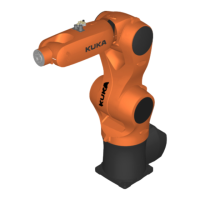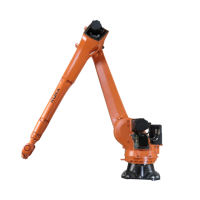Operating Instructions
200 of 206
BA KR 6, 16 F, KR C4 12.10.07 en
8 Exposure limits and personal protective equipment
Ingredient name ACGIH TLVs:
Base oil – unspecified
Limits to monitor: ACGIH (USA).
TWA: 5 mg/m
3
8 hour(s). Form: mineral oil mist
STEL: 10 mg/m
3
15 minute(s). Form: mineral oil mist
The ACGIH values are enclosed for information and orientation purposes. Further information can be
obtained from your supplier.
While this section contains specific OELs for individual components, different components may be
contained in any mists, vapors or dusts that are generated. The specific OELs may thus not necessarily be
applicable to the product as a whole and are merely provided for general information purposes.
Limitation and monitoring of exposure
Limitation and monitoring of exposure in the workplace:
Provide exhaust ventilation or other engineering controls to keep the relevant
airborne concentrations below their respective occupational exposure limits.
Hygiene measures: Wash hands, forearms and face thoroughly after handling chemical products and
before eating, smoking or using the toilet, as well as at the end of the working day.
Personal protective equipment
Respiratory protection:
Not essential. Sufficient ventilation is recommended in industry, however.
Hand protection: Wear protective gloves if prolonged or repeated contact is likely.
Chemical--resistant protective gloves. Recommended: nitrile gloves
The right choice of protective gloves is dependent on the chemicals to be handled,
the working conditions, and the condition of the gloves themselves (even the best
chemical--resistant protective gloves start to leak after repeated contact with
chemicals). Most protective gloves only provide protection for a short period of
time, after which they must be disposed of and replaced. As the specific working
conditions and the chemicals concerned differ from case to case, appropriate safety
measures must be developed for each individual application. Protective gloves
should therefore be selected in consultation with the supplier/manufacturer, giving
full consideration to the specific working conditions.
Eye protection: Protective goggles with side shields to guard against splashing.
Skin and body: Wear appropriate clothing to avoid prolonged skin contact.
9 Physical and chemical properties
General information regarding appearance
Physical state Liquid.
Color: Green.
Odor: Slight.
Important information on health, safety and the environment
Flash point: Open cup: 230 °C (446 °F) [Cleveland]
Vapor pressure: <0.01 kPa (<0.075 mm Hg) at 20°C
Viscosity: Kinematic: 150 mm
2
/s (150 cSt) at 40°C
Pour point: -- 3 6 °C
Density: < 1000 kg/m
3(
<1g/cm
3
)at20°C
Solubility: Insoluble in water .

